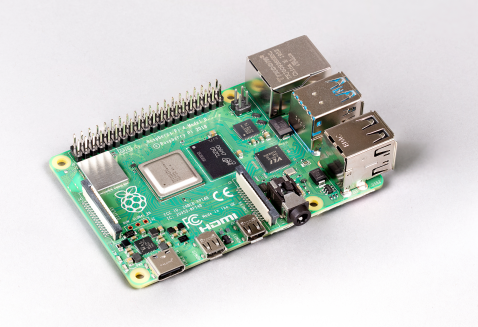The Electromaker Show Episode 1
We're thrilled to announce the Electromaker show, episode 1! Join us as Ian Buckley breaks down the latest happenings in the maker, tech, do-it-yourself (DIY), and crowdfunding world! The week of June 1, 2020 saw a Raspberry Pi 4 8GB model debut, the Elecrow CrowPi 2 announced, a Bigfoot Wi-Fi relay board gets crowdfunded, and more!
Raspberry Pi 4 8GB Unveiled
The good folks over at the Raspberry Pi Foundation have launched a Raspberry Pi 4 model with 8GB of RAM. When the Raspberry Pi 4 first hit shelves, it was available with 1GB, 2GB, or 4GB of RAM. Now, there's a version 50% more memory than the previous flagship tier. All other specs including its system-on-a-chip remain the same. I'm definitely planning to pick up an 8GB Raspberry Pi 4. Recently, I tested out my Pi 4 as a desktop replacement for a week, and was pleasantly surprised at the results. I was able use my Pi to accomplish my day-to-day job of writing, editing, social media management, and light image editing. Plus, I threw some audio editing, gaming, and video playback at it, and the Pi didn't bat an eye.
The 8GB model is a curious addition to the Raspberry Pi lineup. Because the SoC is still the same, the 8GB model probably won't provide the average user with much of a noticeable performance gain. Sure, you might be able to open all the Chromium and Firefox tabs (er...well, maybe not ALL, but quite a lot), but you'll likely bog down the CPU before you max out the 8GB of RAM. Still, for multitasking in a desktop setting or as part of a computing cluster, the 8GB Raspberry Pi 4 should satisfy makers seeking to squeeze a bit more juice out of the RasPi!
Elecrow CrowPi 2
The CrowPi is an all-in-one Raspberry Pi kit from Elecrow, a hardware manufacturer offering a slew of DIY products including a nifty Arduino automatic plant watering system that I quite enjoy. The next version of the CrowPi, the CrowPi 2 is coming out. Elecrow have revamped the CrowPi, taking everything the original did and improving it.
Maintaining a clamshell form factor, Elecrow updated the CrowPi2 with a laptop design so you can use your Raspberry Pi as a laptop. This should make for a neat portable Raspberry Pi set up that's perfect for STEAM education (Science, Technology, Engineering, Arts, and Mathematics), while allowing for a full array of Raspberry Pi sensor connectivity. There's software specifically engineered for the CrowPi 2 which touts Python programming, Scratch, Minecraft, and a slew of other software offerings. Whether you already own a CrowPi and are looking for an upgrade, or this is your first purchase, the next-gen CrowPi2 should be an excellent device.
Bigfoot Wi-Fi Relay Board Crowdfunding Campaign
Have you seen Bigfoot? I haven't, but the Bigfoot Wi-Fi relay board that we spotted looks pretty cool. This Arduino-based launched a successful crowdfunding campaign on Kickstarter and has already met its goal of 898 Euros. Basically, the Bigfoot Wi-Fi relay board is an Arduino microcontroller with wireless connectivity, various relays, and a microSD card slot.
You'll find two different variants, a Wi-Fi option and a Bluetooth version. There's a watertight container and slick construction. For industrial Internet of Things (IoT) applications, the Bigfoot offers a unique feature set. You can set up higher powered devices such as large motors and equipment. While the average at-home maker may be just fine with a basic off-the-shelf Arduino starter kit, the Bigfoot Wi-Fi relay board boasts a watertight enclosure which you could use for underwater electronics such as making your own submarine. Considering its use in aquatic settings, perhaps it should have been named the Loch Ness Monster instead.
Power H mini V2 Motor driver
The Power H Mini V2 motor driver has been announced on Crowdsupply. This tiny motor driver is an H-bridge driver for DC motors. You'll find a 12 A peak current, two-wire control, and PWM onboard. It lets you control the direction, speed, and other variables of a motor. What sets the Power H Mini V2 apart is its size. Around the size of a coin, it's perfect for embedded devices. Its 15mm x 20mm is incredibly small, but very useful. There's no heatsink, so if you're approaching peak amps, you'll need to slap one on. But for most use cases up to about 5 amps, a heatsink likely won't even be necessary.
Ways to Stay Entertained at Home
Have you been stuck at home? If, like us, you've been practicing social distancing and staying at home, there's a lot more than just binging Netflix to do. Make: held a virtual Maker Faire, and those projects are now online for everyone to enjoy. Also hailing from Make: are Typewriter Stories with Dr. Sparks. It's particularly entertaining for young makers, and happens each Monday on the Make: YouTube channel.
There's also the bi-monthly H^4N a Digital Hardware Happy Hour, a virtual event for hardware enthusiasts to discuss projects. Recently, we covered the Bela microcontroller which concentrates on audio programming. Now, team Bela has put out a free C++ Bela real-time audio programming course. You can find it over on their YouTube channel hosted by Dr. Andrew McPherson, Founder and Director of Bela. And of course you can peruse our arsenal of maker tutorials, editorials, and more on Electromaker.io, plus get active in the Electromaker forums!
Did we miss anything? Got a maker news story you're particularly excited about? Let us know in the comments below, and don't forget to head over to the Electromaker YouTube channel where you can subscribe for updates!















































Leave your feedback...